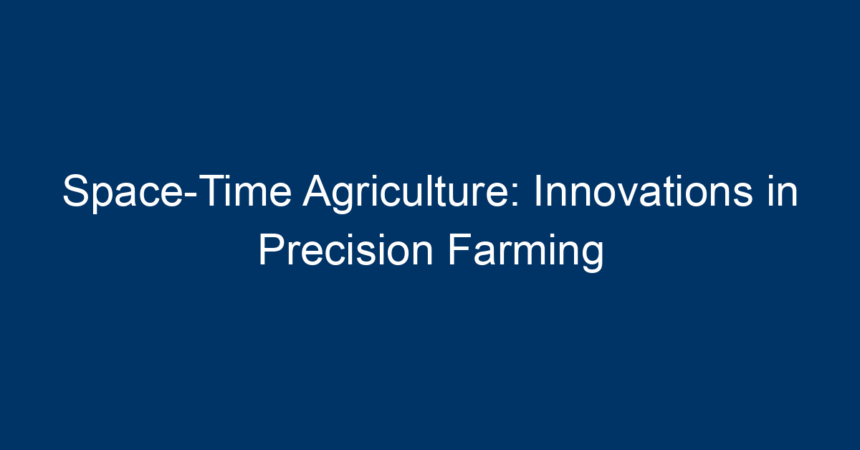In the rapidly evolving landscape of agriculture, traditional methods are giving way to innovative approaches that enhance productivity while minimizing environmental impact. One such transformative concept is space-time agriculture, a methodology merging geography and time into farming practices. This article delves into the innovations in precision farming driven by space-time agriculture, examining its benefits, technologies, and real-world applications, all while providing actionable insights for farmers and stakeholders.
Understanding Space-Time Agriculture
Space-time agriculture focuses on optimizing how and when crops are cultivated. By leveraging data related to space (geographic location and physical resources) and time (timing of planting, harvesting, and resource use), farmers can make informed decisions that enhance productivity and sustainability.
The Need for Space-Time Interventions
As the global population continues to rise—expected to hit nearly 10 billion by 2050—the demand for food will surge. Traditional farming practices struggle to keep pace with this demand, leading to resource depletion and environmental degradation. Space-time agriculture emerges as a solution, ensuring that farming is both efficient and ecologically sound.
Innovations Driving Space-Time Agriculture
1. Geographic Information Systems (GIS)
GIS technology is at the forefront of space-time agriculture. By enabling farmers to visualize and analyze data related to land use, soil health, and crop performance, GIS helps in making strategic decisions. For instance, farmers can identify the best locations for specific crops based on soil types and historical yield data.
2. Remote Sensing
Remote sensing technology employs satellites or drones to collect data about crops over large areas. This innovation allows farmers to monitor crop health, moisture levels, and nutrient deficiencies in real-time. With this data, farmers can tailor their interventions based on spatial needs, enhancing crop yields and reducing waste.
3. Precision Irrigation
Water usage is a critical concern in agriculture. Precision irrigation systems utilize data from soil moisture sensors and weather forecasts to optimize water application. By applying water directly to the roots when needed, farmers can improve water efficiency, conserve resources, and enhance crop resilience—all integral elements of space-time agriculture.
4. Data Analytics and Machine Learning
The ability to analyze large datasets is transforming how farmers approach cultivation. Machine learning algorithms can identify patterns in data generated from various sources, including climate conditions, soil health, and crop yields. This predictive capability allows farmers to make informed decisions about planting times, crop rotation, and resource allocation, fundamentally rooted in space-time agriculture principles.
Benefits of Implementing Space-Time Agriculture
Increased Efficiency
By incorporating space-time agriculture methods, farmers can maximize yields while minimizing inputs such as water, fertilizers, and pesticides. This efficiency not only boosts profitability but also promotes sustainable farming practices.
Environmental Sustainability
With a focus on resource optimization, space-time agriculture reduces the environmental footprint of farming. By minimizing chemical use and conserving water, this approach aligns with sustainable agricultural practices, contributing to soil health and biodiversity.
Enhanced Crop Resilience
With tools such as GIS and remote sensing, farmers can identify vulnerabilities in crop systems related to pests, diseases, or weather fluctuations. This proactive approach allows for timely interventions, enhancing overall crop resilience and food security.
Real-World Applications of Space-Time Agriculture
Case Study: Precision Agriculture at Scale
Farm XYZ, a large-scale agricultural enterprise in the Midwest, exemplifies the power of space-time agriculture. By utilizing a combination of GIS mapping, drone technology, and data analytics, the farm has increased its corn yields by 20% over three years. With real-time monitoring of soil conditions and crop health, tailored interventions have significantly reduced fertilizer use by 30%, demonstrating the dual benefits of improved efficiency and sustainability.
Case Study: Community Supported Agriculture
In Community Farm ABC, a collaborative initiative focused on local organic farming, space-time agriculture methods have been employed to optimize crop rotation and planting schedules based on historical weather data. By aligning their production with market demand and local climatic conditions, they have enhanced community food security, generating better income for local farmers while reducing transportation emissions associated with food distribution.
Challenges in Adopting Space-Time Agriculture
Despite its numerous advantages, space-time agriculture faces several hurdles:
1. Initial Costs
Investing in technology such as drones, sensors, and data analytics can be prohibitively expensive for small-scale farmers. Financial assistance and grants can play a crucial role in bridging this gap.
2. Data Management
Handling vast amounts of data can be overwhelming. Farmers require training and support to effectively interpret and leverage data for practical decision-making.
3. Accessibility
Not all regions have access to the technology and infrastructure necessary for implementing space-time agriculture. Thus, localized solutions need to be developed to make these innovations accessible to all farmers.
Actionable Insights for Farmers and Stakeholders
1. Embrace Technology
Farmers should consider investing in technology that supports space-time agriculture. Start small with affordable tools like soil moisture sensors before moving onto more complex systems.
2. Leverage Local Resources
Collaborating with local agricultural extension services can provide farmers with valuable insights and educational resources to facilitate the transition to space-time agriculture.
3. Continuous Learning
Agriculture is a dynamic field, and continuous adaptation is key. Farmers should stay updated on the latest innovations, attending workshops, and engaging with agricultural communities.
4. Implement Sustainability Practices
Integrating sustainable practices alongside space-time agriculture can further enhance the benefits. Focus on methods that enrich the soil, such as cover cropping and organic fertilization.
Conclusion
The advent of space-time agriculture represents a paradigm shift in farming, addressing the pressing challenges of food security and environmental sustainability. By embracing innovative technologies and methodologies, farmers can enhance productivity while protecting our planet’s resources. As we navigate towards a more sustainable future, the integration of space-time agriculture practices into mainstream farming will be critical.
In an era defined by rapid change, investors, farmers, and agricultural stakeholders alike must recognize the transformative potential of space-time agriculture. The time to innovate is now, and the prospective yield—both in crops and sustainable practices—is ripe for the harvesting.




